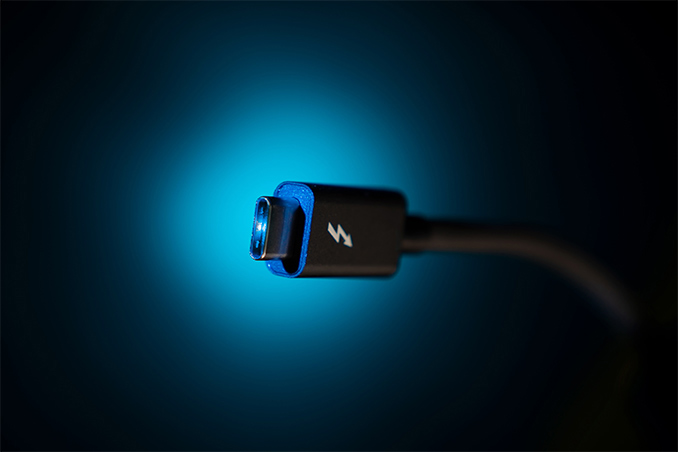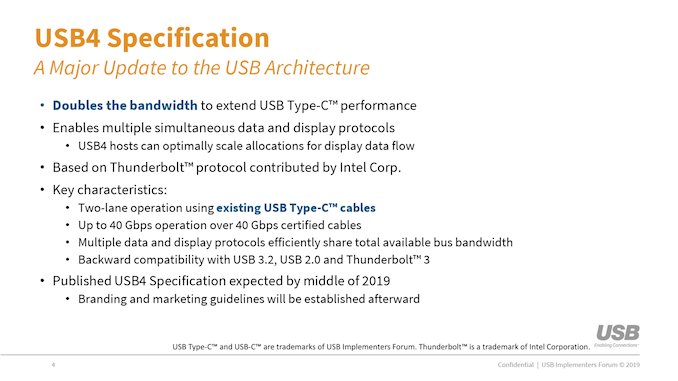Cypress Announces USB 3.2 & USB4-Ready Controllers: EZ-PD CCG6DF & CCG6SF
by Anton Shilov on March 3, 2020 8:30 AM EST- Posted in
- Peripherals
- Thunderbolt
- Thunderbolt 3
- USB
- USB 3.2
- USB4

Cypress has unveiled a pair of upcoming USB Type-C controllers for next-generation desktops and laptops. The new EZ-PD CCG6DF and EZ-PD CCG6SF controllers are single-chip solutions that support USB 3.2, DisplayPort, and Power Delivery with fault protection. In addition, the controllers are ready to work with USB4 devices.
Cypress’s EZ-PD CCG6DF and EZ-PD CCG6SF are highly-integrated dual-port and single-port USB-C controllers. Both controllers are based on a 32-bit Arm Cortex-M0 processor, with 64 KB of eFlash to enable enhanced programmability as well as firmware upgrades to gain new functionality or deploy bug fixes. The controllers connect to their host using a PCIe interface and support a variety of protocols, including USB 3.2, DisplayPort, and PCIe.

Meanwhile, the controllers also offer a limited degree of support for USB4; however just what this entails is somewhat murky. According to the company's press release, the new controllers support "firmware upgrades to support the new USB4 standard", however we've been told sperately by the company that the chips are not USB4 controllers. Further still, the company does use the USB4 logo on the product page. What this may come down to is data rates: USB4 offers both 40Gbps and 20Gbps rates, and while both use the standard's fully encapsulated packet format, the 20Gbps data rate isn't any faster (or using any additional wires) than what today's SuperSpeed USB 20Gbps (Gen2x2) devices can already do. So if Cypress is waiting to enable USB4 support at a future date, it could very well be that they will (eventually) be usable as USB4 20Gbps controllers.
Moving on, one of the other important capabilities of the new chips is an integrated VBUS provider load switch, which allows the chip to support 100 W Power Delivery with fault protection. The integration of switch reduces design footprint and BOM costs, which is helpful for getting wider-spread support for high capacity USB power delivery.
Cypress uses an unknown process technology to build the EZ-PD CCG6DF and EZ-PD CCG6SF controllers and will offer them in 96-pin BGA and 48-pin QFN packages to support various requirements.
Cypress has started sampling of its EZ-PD CCG6DF and EZ-PD CCG6SF controllers with major OEMs. The company expects to start volume production in early Q3, so we may see consumer products by the end of this year.
Related Reading:
- USB-IF: USB4 Products Coming in Late 2020
- USB4 Specification Announced: Adopting Thunderbolt 3 Protocol for 40 Gbps USB
- Cypress and Zhaoxin Have USB 3.1 Gen 2 USB Controllers
- Infineon Set to Acquire Cypress for $10 Billion
Source: Cypress











17 Comments
View All Comments
Kaggy - Tuesday, March 3, 2020 - link
Hardware, costs and feasibility.It is unlikely a mobile phone can encompass the hardware for 100W PD and it'll add unnecessary additional costs to a mobile phone to design bandwidth for 40Gbps.
I think the main issue is logo design, being unable to differential between the different threshold between each cables and ports is annoying.
wolrah - Wednesday, March 4, 2020 - link
I interpreted the question more as "why do they insist on rebranding the older speeds under the new name?" so a phone would be called USB 2.0, 3.0, or 3.1 rather than 4.0 if it didn't have the full speed capabilities. Obviously this question is sort of rhetorical, because we know it's purely so marketing idiots can put a bigger number on the box without any cost (other than consumer confusion, which marketing/sales people generally consider a positive). Anyone who doesn't know what's going on shopping for an new USB card/hub/external drive/whatever is going to look at USB 3.2 Gen1 as being better than USB 3.0, and might even pick it over 3.1 Gen2.I've posted it here before, but I really wish tech journalists would stand up to the USB-IF and refuse to play this game.
If it's 5 gigabits per second it's not USB 3.1/3.2 Gen1 or whatever nonsense name is probably coming along with 4.0, it's USB 3.0. 10 gigabits single lane is USB 3.1, and the 2x5/2x10 gigabit modes are 3.2. Call it by the name it's best compared by and call out the companies that are aiming to confuse.
repoman27 - Wednesday, March 4, 2020 - link
1. The version number of a particular release of the USB specification isn't a brand. It's entirely normal to increment version numbers for new releases of things while deprecating older versions.2. The version number of a specification cannot determine the exact capabilities of any particular device or product implementing it if there are any optional features included in the specification.
3. The USB-IF has consistently advised manufacturers, marketers, and the media not to use USB specification version numbers to indicate device capabilities and to clearly state supported link rates wherever there is possibility for confusion.
4. The USB-IF freely publishes USB specifications and does not require certification or logo compliance for products. The result is one of the most successful and widespread I/O interfaces in history, with thousands of manufacturers worldwide producing billions of USB devices annually.
5. Even if the USB-IF possessed the resources required to globally police the usage of USB version numbers on product packaging or in marketing materials, they have no legal mechanism for doing so.
6. The USB-IF has registered trademarks for "USB4" and "USB Type-C" with the USPTO as standard character marks, so they may be learning their lesson. In other words, those actually are legally protected brands now, rather than just version numbers of a freely available document.
7. The media has largely focused their efforts on exacerbating the problem in order to increase "engagement", rather than attempting to clarify the situation or adopting sensible conventions as part of their style guides.
8. Very few customers care about the specific capabilities of USB3 devices as long as they function as intended. If support for dual-lane operation or the difference between Gen 1 and Gen 2 physical layer signaling is actually important to you or your workflow, then it's not that hard figure these things out.
repoman27 - Tuesday, March 3, 2020 - link
These are not USB or Thunderbolt host controllers, they are USB Type-C port controllers. Big difference.The high-speed differential signaling pairs (SuperSpeed USB, Thunderbolt, DisplayPort) never touch these chips. Instead, they perform USB Power Delivery communication over the CC pins, negotiate power contracts, control the VBUS, provide pass-through for the SBU channel, and muxes for the USB 2.0 D+/D- pins. This is why they are capable of supporting USB 3.2, Thunderbolt 3, DisplayPort, or USB4 applications with the right firmware.
A fairly comprehensive datasheet is available from Cypress on the page linked to in the article.
ksec - Wednesday, March 4, 2020 - link
Am I the only one with broken image in the middle.Ryan Smith - Wednesday, March 4, 2020 - link
It would seem that way.https://images.anandtech.com/doci/15567/CCG6DF_CCG...
Is that not loading for you?
crumplez - Thursday, March 5, 2020 - link
To be clear, many of you are confusing the new name standards that USB-IF has changed..Officially :
USB 3.1 Gen 1 (5Gbps) is the same thing as new name : USB 3.2 Gen 1 (5Gbps).
Same thing for USB 3.1 Gen 2 (10gbps) new name: USB 3.2 Gen 2 (10gbps).
The upcoming releases for speeds will also be.. USB 3.2 Gen 2x2 = (20Gbps)
Everyone should start referencing properly instead of spreading more confusion. Direct screenshot from USB-IF documents. https://imgur.com/ytDRYOq